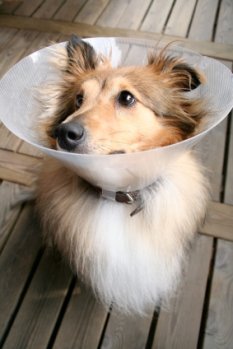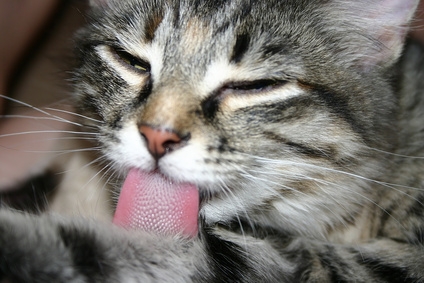

Accidents happen. A first aid kit specifically meant for your pets is helpful because it provides stuff that's often not found in a first aid kit for people. You can buy a kit or assemble your own at home by gathering the items and storing them in a hard plastic container with a tight-fitting lid. Here are a few suggestions on what to place in your pet first aid kit.
DOCUMENTATION: protect your documentation from getting wet by laminating it.
- The name, phone number, address, and directions to both your regular veterinarian as well as an emergency vet clinic.
- List of medications and dosages, if your pet has a medical condition that requires regular treatment.
- Phone number for a Poison Control Centre.
MEDICATION: ask your vet for help in putting together
this part of your kit.
- Disinfectant and antibiotic ointment.
- Sterile saline solution.
- Ear cleaning solution.
- Canine aspirin.
- Hydrogen peroxide.
- Activated charcoal.
- Eye wash solution.
- Anti-diarrhea medication.
- Allergy medication.
- Medication to relieve itching.
TOOLS / EQUIPMENT:
- Muzzle (make sure it's a proper fit).
- Eye dropper and oral syringe.
- Tweezers.
- Nail clippers.
- Needle-nose pliers.
- Scissors.
- Nylon slip-leash.
- Disposable gloves.
- Clean towels.
- Paper towels.
- A large blanket, which can be used as a stretcher
if you have to move your pet.
- A second blanket to keep your pet warm.
- Cold and heat packs (wrap in a towel - do not place
directly against your pet).
SUPPLIES:
- Roll of gauze (can be used to make a muzzle if needed).
- Sterile gauze pads.
- Bandage rolls, such as VetWrap.
- First aid tape.
- Lubricant.
- Cotton balls and swabs.
- Styptic powder or pencil.
- "Bitter Apple" (or similar pet-safe product) - a product that discourages dogs from chewing or licking where the product is applied.
- Nutritional supplements - ask your vet for suggestions.
ADDITIONAL TIPS:
- Don't give your pet human medication unless advised to do so by your veterinarian.
- Don't give your dog medication that's meant for cats, or vice versa.
- Always take precautions when handling an injured pet. Even the most gentle, sweet-natured pet may bite if it is hurt or scared.
- Know how to use the items in your first aid kit. Pet first aid courses can provide instruction. When possible, consult your vet first, particularly before administering medication.
- Periodically check the expiration dates on medications and replace them as necessary.
- Keep a portable crate next to your pet first aid kit.
- Keep your kit in an easily-accessible place in your home, and remember to take it with you when you travel with your pet, too! You can assemble a smaller kit for use during travel if you wish. family - pets included!
To request reprint permission please contact us.
 Deciding Upon Real-world Solutions Of After Hours Veterinarian
Deciding Upon Real-world Solutions Of After Hours Veterinarian
 Dog Wellness - Safety, Wellness And Health Tips
Dog Wellness - Safety, Wellness And Health Tips
 Keeping Up with Your Pet's Health: Vaccinate with Rabies Shots
Keeping Up with Your Pet's Health: Vaccinate with Rabies Shots
 How to Care for Dissolvable Stitches After Spaying a Pet
How to Care for Dissolvable Stitches After Spaying a Pet
 Important Documentation for Your Pet
Important Documentation for Your Pet
 Emergency Planning Tips for Pet Owners
Emergency Planning Tips for Pet Owners
Copyright © 2005-2016 Pet Information All Rights Reserved
Contact us: www162date@outlook.com